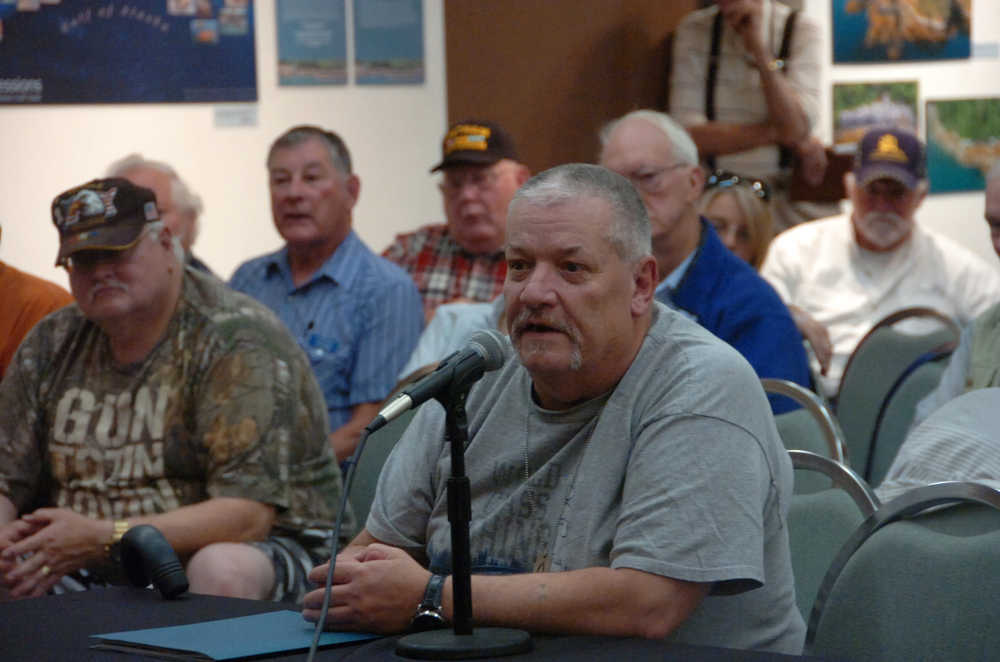Dozens of residents filled the Kenai Chamber of Commerce and Visitor Center conference room Monday for the chance to voice their opinions about the Veterans Access, Choice, and Accountability Act, which was implemented in Alaska in August 2014.
Frustrated veterans repeatedly referred to the program set up by the act as the “No Choice Program” during the Veterans Affairs listening session, held to flesh out issues with how the act, nicknamed the Choice Act or the Choice Program, has been run in its first year.
For more than two hours, Sen. Dan Sullivan (R-Alaska) and Dr. David Shulkin, the VA’s new under secretary for health, listened to testimony and suggestions from area veterans. The pair also heard from Fairbanks veterans Monday.
The program, designed to benefit veterans facing long wait times and living in rural areas, has so far failed to improve access to VA services in the state. The program was given 90 days to get up and running once it was initiated.
“It (the Choice Act) is not working particularly for Alaska,” Sullivan said. “The irony is that the Choice Act got many of its innovations and ideas from Alaska, and yet now that it’s being implemented, the state where it’s not working at all is the state where many of the ideas in the bill came from.”
Sullivan and Shulkin also heard a statement given over the phone from a representative of veterans in Dillingham, who wanted the chance to be heard during the Kenai session. Around 55 people signed up to speak Monday night, but the scheduled period did not allow everyone to be heard. Those who still wish to comment on the Veterans Choice Act can send their statements to public_testimony@sullivan.senate.gov, which will remain open through Sept. 1.
Complaints heard at the listening session were about lack of communication, properly-trained employees and accountability. Longer wait times were also cited as an issue.
Kenai resident and veteran Daniel Newman cited long wait times and appointment scheduling issues as major problems with the Choice Program.
“One of my issues is filing for disability, on PTSD (Post Traumatic Stress Disorder),” Newman said. He went on to say that his brother in another state waited more than three years for his own veteran services.
“I have stage three throat cancer,” Newman said. “I don’t (even) have three and a half years.”
Newman served two tours with the United States Army, one in Germany and another in Korea. He was told he missed the August 2014 deadline to receive a Choice Card, which would make him eligible to receive services through the program. Newman said the unique situation of veterans in Alaska is what makes getting VA services difficult, but that people who need those services will still move to Alaska for good reason.
“I think it’s for more than one reason,” Newman said. “I had a hard in there. I mean I had tears a couple times because I can’t handle being in crowds. I can’t even go to the store when it’s crowded … and I think there’s a number of people that are like me that moved up here to get away from that.”
Problems caused by the quickly-implemented Choice Program are not felt by Alaska’s veterans alone.
Derotha Ferraro, director of public relations and marketing for the South Peninsula Hospital, presented the issues health service providers have run into while working under the new system.
Ferraro testified on behalf of the hospital, saying that issues with the program have thrown a wrench into the hospital’s VA services.
For example, the program only allows providers to log into its website once per day. If the provider accidentally logs out or gets timed out, they cannot access the program online until the next day, Ferarro said.
“As the PR director, I’ve been somewhat connected to veterans concerns over the last couple of years,” Ferraro said. “Based on my knowledge I would say the number one priority would be to get their customer service reps trained.”
Ferraro said the VA and the Choice Program seem to operate like two separate entities with no communication between them.
The fact that the timeframe for being paid back for VA services is unknown is also problematic, she said.
Despite these and other issues, Ferraro said she likes the original goal of the program — to better serve rural veterans with limited access to the VA.
“Well, it opened up the door for veterans to be treated for various things at the local level … instead of veterans having to drive to Anchorage,” Ferraro said. “They can get their care right in the community. It’s a great idea. They should have been doing it all along.”
Shulkin said after the session that the praise for local VA services was something different he picked up on at the Kenai listening session.
“People uniformly value and appreciate the care that they’re getting at the local Kenai veterans office,” Shulkin said.
“And the message was that we need to give them more local control, because that’s where the trust is and that’s where they believe that their best interests are held.”
Sullivan and Shulkin finished gathering testimony at a formal hearing in Eagle River on Tuesday.
A plan for addressing the Choice Program’s issues in Alaska will be presented to Congress by Nov. 1, Shulkin said.
The solution to Choice Program issues will be found through collaboration between the VA, Congress and the program’s third party administrators, Shulkin said,
“I own the problems now,” Shulkin said. “I may not have caused them, but I own them.”
Reach Megan Pacer at megan.pacer@peninsulaclarion.com.

